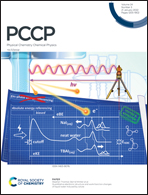Energy decomposition analysis method for metallic systems†
Abstract
In this work, we present the first extension of an energy decomposition analysis (EDA) method to metallic systems. We extend the theory of our Hybrid Absolutely Localized Molecular Orbitals (HALMO) EDA to take into account that molecular orbitals in metallic systems are partially occupied, which is done by weighted orthogonalization (WO) of the molecular orbitals using their associated fractional occupancies as weights in the construction of the projection operators. These operators are needed for the self-consistent field for molecular interaction (SCF MI) computation of the polarization-energy contribution to the interaction. The method gives more weight to orbitals that have higher occupancies and treats each fragment as metallic. The resulting HALMO EDA for metallic systems naturally reduces to the insulator version and produces the same results when applied to an insulating system. We present the theory and implementation of our new approach, and we demonstrate it with sample calculations of relevance to industrial materials. This work provides a new EDA paradigm and tool for the study and analysis of interactions in metallic systems within large-scale DFT calculations.



 Please wait while we load your content...
Please wait while we load your content...